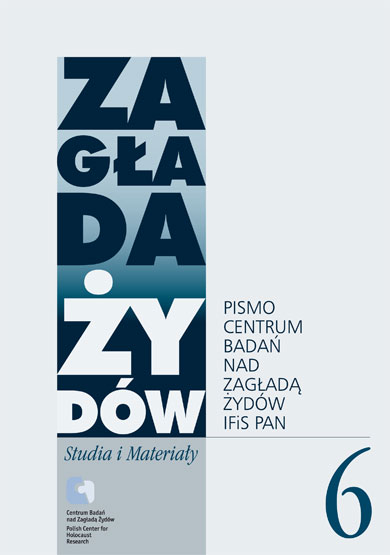„A ziemia się jeszcze ruszała...” Masakra Żydów w Szczeglacinie w relacjach świadków
Zagłada Żydów. Studia i Materiały, Nr 6 (2010), Strony: 179-192
Data zgłoszenia: 2020-12-06Data publikacji: 2010-12-30
 https://doi.org/10.32927/zzsim.715
https://doi.org/10.32927/zzsim.715
Abstrakt
The article deals with a labor camp for Jews founded by the Germans in Cerkwisko near Bartków Nowy, Karczew Commune, was transferred to the village of Szczeglacin due to the works’ extension along the river. The Jews who died in that camp performed work connected with water management which consisted of farmland draining and engineering on Kołodziejka, a tributary of Bug river. The liquidation of the Szczeglacin camp took place probably in the morning of 22 October 1942. Several hundred Jews were killed with a primitive tool – a wooden club. According to the witnesses, “when spring came,” likely in 1944, the Germans returned to the spot to conduct an exhumation of the remains in order to ultimately cover the traces. The article is based on various sources – from oral accounts, collected in 2009 in Szczeglacin and the neighboring villages, through records produced in 1947 (Josek Kopyto’s testimony) and 1994 manuscript of a peasant from Bartków Stary as well as regional publications.
Słowa kluczowe
Zagłada Żydów , obóz pracy w Szczeglacinie
Licencja
Prawa autorskie (c) 2010 Autor & "Zagłada Żydów. Studia i Materiały"

Utwór dostępny jest na licencji Creative Commons Uznanie autorstwa 4.0 Międzynarodowe.
https://creativecommons.org/licenses/by/4.0
Inne teksty tego samego autora
- Marta Woźniak, “And the Earth Was Still Moving…” The Massacre of Jews in Szczeglacin in Eyewitness’ Testimonies , Zagłada Żydów. Studia i Materiały: 2010: Holocaust Studies and Materials
Podobne artykuły
- Stefan Marcinkiewicz, Sammellager Bogusze (2 listopada 1942 – 3 stycznia 1943 r.) jako przykład przejściowego obozu zbiorczego podczas akcji „Reinhardt” w okręgu białostockim , Zagłada Żydów. Studia i Materiały: Nr 20 (2024)
- Victoria Van Orden Martínez, Emocje jako świadectwo. Aspekt psychologiczny składania przez ocalałych relacji przed komisją historyczną tuż po wojnie , Zagłada Żydów. Studia i Materiały: Nr 20 (2024)
- Jean-Charles Szurek, Witold Mędykowski, Michael Meng, Emanuel Althuber, Michael Fleming, Omówienia najnowszych publikacji na temat zagłady Żydów - Francja, Izrael, USA, Austria, Wielka Brytania , Zagłada Żydów. Studia i Materiały: Nr 1 (2005)
- Agnieszka Haska, “I knew just one little Jewess hiding . . .” The case of Zofia and Marian Chomin - edited and introduced by Agnieszka Haska , Zagłada Żydów. Studia i Materiały: 2010: Holocaust Studies and Materials
- Noam Rachmilewicz, Archiwum Żydowskiego Komitetu Narodowego w Warszawie 1943–1944 , Zagłada Żydów. Studia i Materiały: Nr 19 (2023)
- Emanuel Berman, Adolf Abraham Berman (1906–1978) , Zagłada Żydów. Studia i Materiały: Nr 19 (2023)
- Iwona Kurz, “This picture is a little horrific”. The story of a film, or the Polish nation face-to-face with the Jew , Zagłada Żydów. Studia i Materiały: 2010: Holocaust Studies and Materials
- Janusz Salamon, SJ, Christian-Jewish Dialogue in the Land of Sick Imagination. On the Margins of Waldemar Chrostowski’s Book Kościół, Żydzi, Polska , Zagłada Żydów. Studia i Materiały: 2010: Holocaust Studies and Materials
- Jacek Leociak, Stanisław Śreniowski, z księgi obłędu i ohydy , Zagłada Żydów. Studia i Materiały: Nr 1 (2005)
- Romuald Jakub Weksler-Waszkinel, Jak Pawłowski ukrywał Grinera [Sługa Mesjasza. Z ks. Grzegorzem Pawłowskim/Jakubem Herszem Grinerem rozmawia Lucyna Montusiewicz, Lublin, wyd. Gaudium 2005] , Zagłada Żydów. Studia i Materiały: Nr 1 (2005)
<< < 26 27 28 29 30 31 32 33 34 35 36 37 38 39 40 41 42 43 44 45 46 47 48 49 50 51 52 53 54 55 56 57 58 59 60 61 > >>
Możesz również Rozpocznij zaawansowane wyszukiwanie podobieństw dla tego artykułu.
 English
English
 Język Polski
Język Polski








